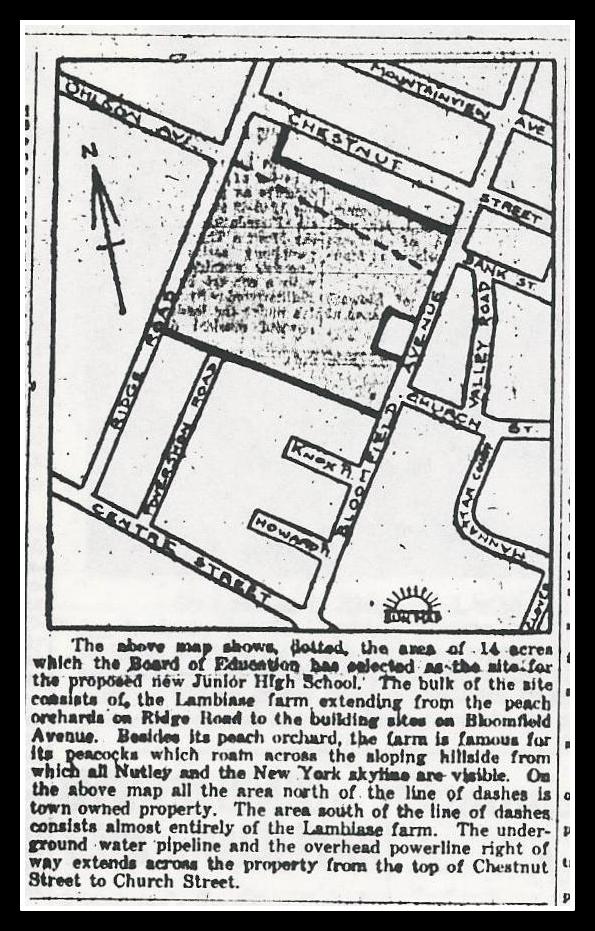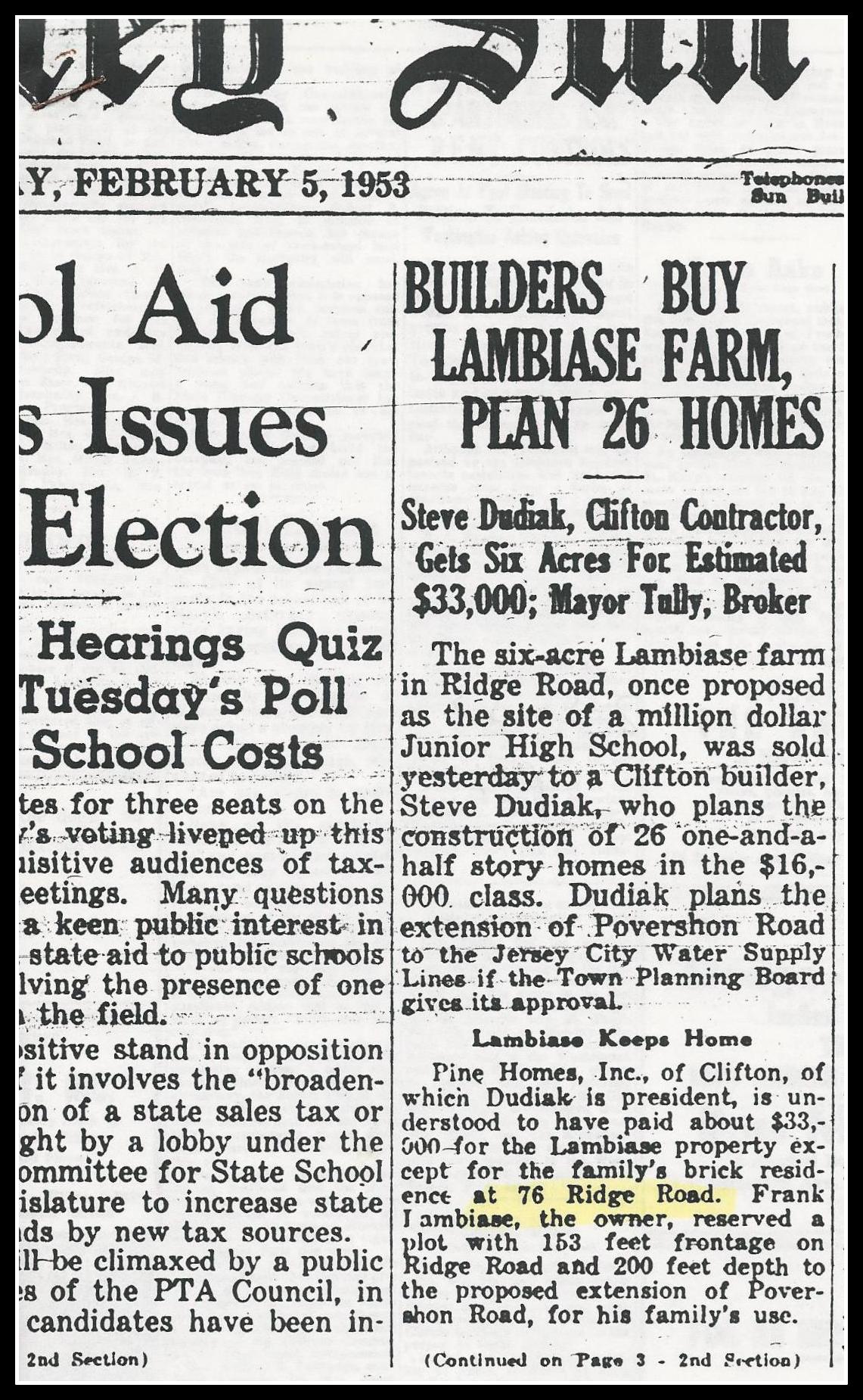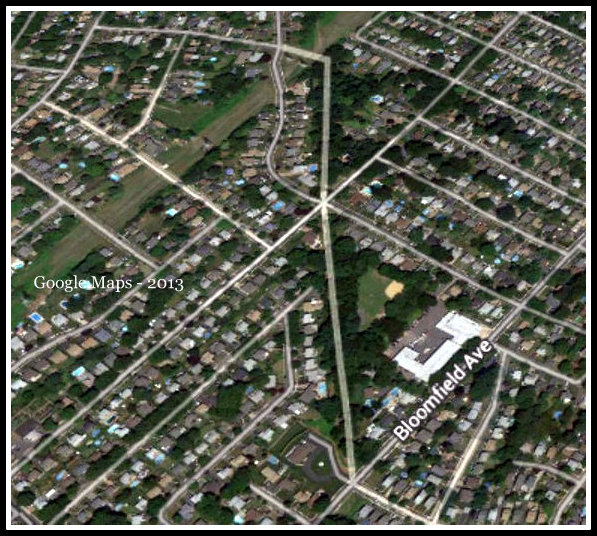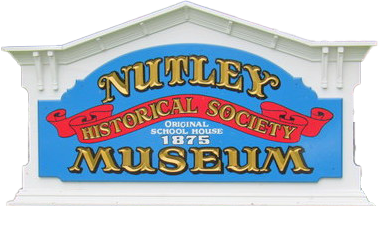Lambiase Farms
12-acre Lambiase farm considered for part of new Nutley Junior High between Bloomfield Avenue and Ridge Road
Caption: On a hilltop in Ridge Road, will all Nutley rustling below and the skyscrapers of New York forming the Eastern horizon, lies the Lambiase 12-acre farm which, along with about 2 acres of town-owned land, the Board of Education seeks to acquire as a site for the proposed Junior high school. In the photo above the farmhouse, barn and barnyard are shown. At the right of the photo, the peach orchard of several acres covers the soft-rolling hillside. Peacocks now roam at liberty under the heavily-laded trees. It is the Board's desire to have the main building where this farmhouse stands and use the sloping terrain for a play area.

Commission Plans Street Across Junior High Site Ignorant of School Board's Aims, Votes To Buy Land Needed For Project
(The Nutley Sun, Aug. 20, 1948) -- Unwittingly, the Town Commission almost cut into the plot of ground which the School Board wants for the proposed new Junior High School by carving out a semi-circular street running from Chestnut Street to Bloomfield Avenue to open up for disposal a tract of 13 building lots, now landlocked, which the Town owns. Until today the Board of Education had not informed the Town Commission of its selection of a school site.
Finance Director Robert R. Anderson introduced the resolution at Tuesday night’s Commission meeting calling for the purchase of enough land to open up the tract which is now cut off from the streets. The Anderson resolution, seconded by Commission Lucy, passed on the first reading was phrased as follows:
“That the town of Nutley purchase from Andrew E. Bloxmorn and William E. MacFarland property known as Block 196 south side of Chestnut Street, for the sum of $1,500, said property being acquired in order that the town of Nutley may open a street running from the south side of Chestnut Street to the west side of Bloomfield Avenue as shown in the master map of the Town Planning Board.”
The thirteen town lots lie at the extreme northern edge of the fourteen acre tract which the Board of Education seeks to acquire as a school site. Without the town owned lots, the site would not be large enough to accommodate the school and all the needed play area.
As soon as District Clerk Everett Zabriskie learned of the Commission’s action, Wednesday, he communicated with Miss Florence Koclea , Town Clerk, and recalled the letter which the School Board had addressed to the Commission two months ago asking the town authorities not to dispose of the land.
It is likely, however, that even if the town does not sell its lots, it will proceed to make the $1,500 investment in Chestnut Street property so as, eventually, to be able to open up the landlocked tract if the School Board fails in its efforts to obtain a bond issue to finance the building.
The question arose yesterday of holding the Lambiase farm and adjoining town owned plot for future town or school as one of the last plots of that acreage left open in Nutley. If the bond issue is defeated at the October election, the Board would be without authority to buy the tract.
If that situation arises, however, it is not impossible that the School Board would return almost immediately before the voters with another plebiscite on the question of buying and holding the land without building until prices come down.
It is generally agreed that in view of the great amount of construction now in progress on Chestnut Street and Bloomfield Avenue, the Lambiase farm would not long remain untouched, and once that tract is subdivided there would not be a single plot of ground of 14 acres left open in town anywhere north of Chestnut.
The Board of Education has also begun negotiations with the holders of land easements for the three water pipelines and one telephone cable which cut across the proposed school is at an angle from the head of Chestnut Street to Church Street.
There are three water pipelines side-by-side just under the surface. One is owned by the Passaic Valley Water Company, another by the City of Newark and the third by the New Jersey District Water Supply Company. They carry reservoir water from the Wanaque region to North Newark. The telephone cable carries long distance lines from Newark, and like long distance lines all through the state may then be placed underground.
See Also: School Board gives its reasons for Lambiase Farm site (Nutley Sun, Aug. 20, 1948)
1948 Election Final Decider on Junior High


BUILDERS BUY LAMBIASE FARM, PLAN 26 HOMES
Steve Dudiak, Clifton Contractor Gets Six Acres For Estimated $33,000; Mayor Tully, Broker
(The Nutley Sun, Feb. 5, 1953) -- The six-acre Lambiase farm in Ridge Road, once proposed as the site of a million dollar Junior High School, was sold yesterday to a Clifton builder, Steve Dudiak, who plans the construction of 26 one-an-a-half story homes in the $16,000 class. Dudiak Plans the extension of Povershon Road to the Jersey City Water Supply Lines if the Town Planning Board gives its approval.
Lambiase Keeps Home
Pine Homes, Inc., of Clifton, of which Dudiak is president, is understood to have paid about $33,000 for the Lambiase property except for the family's brick residence at 76 Ridge Road. Frank Lambiase, the owner, reserved a plot with 153 feet frontage on Ridge Road and 200 feet depth to the proposed extension of Povershon Road, for his family's use.
Mayor James J. Tully, of Belleville, was the real estate broker in the transaction. Trully (sic) confirmed that the sale was completed yesterday and estimated the Clifton Builder's investment in the project at about $350,00.
Dudiak has just finished building 67 homes in Belleville, of a smaller bungalow type which were in the $18,000 class, bringing his total of homes built in this area to more than 6,000.
It is Dudiak's intention to ask the Planning Board to allow him to cut up the property into lots of 50-feet frontage on Ridge Road and Povershon Road 450 feet to the water pipeline, at his own expense and provide a turning space at the end of the dead-end.
If the planning board moves swiftly on his bid for the necessary variance, Dudiak plans to start building in the summer so that the entire development can be completed this year. The homes will be of five or six rooms, fitting into a complete development but with certain architectural differences to avoid a similarity of appearance.
The Lambiase farm is Nutley's last big open tract except for the Plenge farm. In recent years it has not been farmed except for a peach orchard. Before disposing of the farm, Lambiase sold off several tracts of land on Bloomfield Avenue to members of the family.
Sources: The Nutley Sun, August 20, 1948, February 5, 1953.

Who was Paul Rodney Radcliffe?
 Paul Radcliffe came to Nutley in 1920 when the population was 9,431, and upon his retirement as superintendent of schools the town had grown beyond 21,000. During his 14-year reign, Radcliffe spent nearly $2 million on school buildings doubling student capacity. He built additions for all four elementary schools, an addition on Park school and created the junior high.
Paul Radcliffe came to Nutley in 1920 when the population was 9,431, and upon his retirement as superintendent of schools the town had grown beyond 21,000. During his 14-year reign, Radcliffe spent nearly $2 million on school buildings doubling student capacity. He built additions for all four elementary schools, an addition on Park school and created the junior high.
Radcliffe was a self-made educator who began his career in a one-room school at Raven Rock, Pa., near Doylestown where he was born in 1875. At 19, he gave up teaching and worked his way through schools to Columbia University where he earned his Master's. Before coming to Nutley, he worked in public schools in Flemington and Red Bank, both in New Jersey.
In 1936 the Park Oval Association was formed under Radcliffe as president and F.G. Simmons as vice president proceeded to fence in and improve the stadium with surrounding Japanese cherry trees. The group sold bonds which were repaid from game revenue. The Oval stadium, fenced in and planted, was completed and turned over by the association to the school board at the Thanksgiving Day game with Kearny in 1937. It had cost $16,500 in cash.
Radcliffe died at home on Jan. 14, 1947. A few years later, the board of education began construction on the $600,000 Radcliffe School on Bloomfield Avenue. The one-story building with 12 larger-than usual classrooms was set to accommodate 400 pupils while relieving overcrowding at Spring Garden and Lincoln schools. It opened in 1955.
Sources:
Nutley Notables - The Men and Women Who Made a Memorable Impact on Our Home Town, Nutley, New Jersey By Anthony Buccino
Clippings from the collection of Edward T. Stecewicz, former president of the Nutley Historical Society
1948 election news clip courtesy of David Wilson, author of Fire In Our Lives
